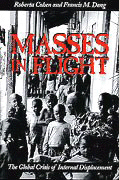INTRODUCTION
This manual is meant to provide guidance to national authorities seeking to prepare and enact domestic legislation and policies addressing internal displacement in their country. In presenting advice on how to shape laws and policies addressing the protection and assistance needs of internally displaced persons (IDPs) and ensuring their rights, the manual draws on two key sources[1]:
- the rules of international human rights law and international humanitarian law, as reflected in the UN Guiding Principles on Internal Displacement (hereinafter Guiding Principles).
- an increasing body of IDP-specific laws and policies already enacted and implemented by national authorities in countries of every region in the world
As the Guiding Principles underline, it is not the international community but national authorities that “have the primary duty and responsibility to provide protection and humanitarian assistance to internally displaced persons within their jurisdiction” (Principle 3(1)). The manual aspires to recognize the efforts made by national authorities in many countries to assist and protect IDPs, to highlight laws and policies that have been most compatible with international law norms, and to encourage and assist those in positions of responsibility in other countries affected by internal displacement to undertake the difficult but crucial task of drawing up protective laws and policies of their own.
To prevent internal displacement, protect the displaced during displacement, and find durable solutions for them once the cause of displacement no longer exists requires no more and no less than respect for human rights and, in armed conflict situations, the protective rules of international humanitarian law. As a result, in some situations the protection of IDPs’ rights demands the same measures as are necessary to protect the rights of all citizens, regardless of whether or not they are displaced. For instance, a central means of implementing the right to liberty and security of person is the passage of legislation setting out protections against arbitrary arrest or detention that are applicable to all citizens, whether or not they are displaced.
However, in many other cases, the fact of displacement works against IDPs, creating both physical and administrative obstacles to the realization of their rights that do not apply to non-displaced citizens. For instance, non-displaced persons are not in need of shelter nor do they have to leave their property behind, risking that it will be taken over by somebody else. Likewise, achievement of the right to political participation is beyond the reach of IDPs in situations where they can only exercise their right to vote at a place of origin they cannot safely return to. It is the technical and legal complexities of addressing such displacement-specific protection needs that are at the heart of this manual.
This manual is addressed to national policymakers, competent ministries, legislators, and civil society groups concerned with internal displacement in the hope that it will be of direct and concrete assistance in crafting laws and policies that will prevent internal displacement wherever possible and mitigate its effects on the lives of IDPs worldwide. The manual will also be of use to the Representative of the Secretary General on the Human Rights of Internally Displaced Persons (RSG) and his international partners in their ongoing efforts to promote effective national laws and policies to prevent, address, and resolve internal displacement.
[1] Due to the technical character of this manual, the acronym IDPs is used throughout the text even though it tends to obscure the fact that those affected by displacement remain human beings with specific vulnerabilities and needs—a fact that is better reflected by the notion of internally displaced persons.
